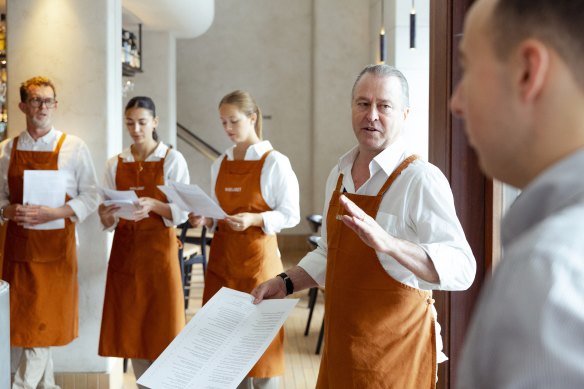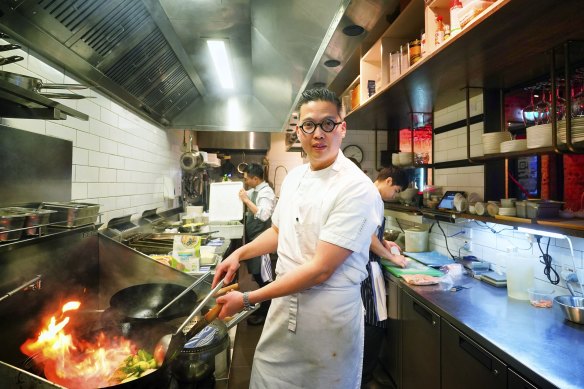- Exclusive
- Environment
- Sustainability
- Cooking
Why the stovetop is the last front in war on household gas
By Caitlin Fitzsimmons and Bianca Hall
If the phrase “now you’re cooking with gas” sparks recognition, that is because the gas industry came up with the slogan in the 1930s.
Ninety years later, household electrification proponents find stovetops remain the last hurdle to getting people to disconnect gas in their homes.
Virginia Jones, the Australian program manager for the Global Cooksafe Coalition, said people had an emotional attachment to how they cooked, but not to how they heated their home or their water.
“Kitchens are the final gateway – if we can get fossil fuels out of kitchens, we can get them out of buildings generally because cooking is what people care about,” Jones said. “They have an emotional connection to the way that they’ve been brought up.”
Her not-for-profit organisation is driven by the fact domestic electricity has lower greenhouse emissions than gas, and that will fall even further as renewables, including rooftop solar, are built at scale.
When talking to consumers, she promotes the hefty savings – hundreds of dollars a year by most estimates – and health benefits available from disconnecting gas. Peer-reviewed Australian studies suggest 12 per cent of childhood asthma cases are directly attributable to gas stovetops, and adults aged 43 to 53 are 2½ times more likely to have persistent asthma symptoms if they have gas stoves and gas heating at home.

Award-winning chef Neil Perry is a long-term fan of induction cooking.Credit: Dominic Lorrimer
A number of property development partners have joined the coalition and committed to not installing gas in new developments after 2030. The Property Council of Australia is the most recent member.
A growing number of chefs are joining the effort to promote induction cooking to consumers, a form of cooking that uses electric currents to directly heat pots and pans through magnetic induction.
Neil Perry, founder of Rockpool Group, is a long-term fan of induction cooking and one of the Global Cooksafe Coalition ambassadors, a strictly voluntary role. Others include Sydney chefs Peter Gilmore from Quay and Bennelong, Danielle Alvarez, founder of Fred’s, Dan Puskas from Sixpenny, Darren Robertson from Three Blue Ducks, and restaurateur-turned-author Christine Manfield, and Melbourne chef Hugh Allan from Vue Group.
It is often assumed that wok cooking is better on gas, but a growing number of specialists in Asian cuisine say otherwise.
Victor Liong, whose modern Chinese restaurant in Melbourne, Lee Ho Fook, has repeatedly won two coveted Good Food Guide hats, is part of a growing number of chefs preparing to make the switch to induction cooking.
Liong’s newly opened Singapore restaurant Quenino is fully electric, with woks sitting in custom-made induction domes. Induction elements cool faster than gas burners, making cleaning quicker and easier, he saves money on expensive and toxic cleaning chemicals, and the radiant heat is vastly reduced, making the kitchen a more comfortable environment for chefs.
He’s now preparing to convert his Melbourne kitchen to induction. At present, he estimates four out of five injuries in the restaurant are from cleaning the kitchen after a busy shift and accidentally touching the hot stove where the wok burner has sat for five hours.
Despite assumptions to the contrary, Liong said Chinese cooking is often better done on induction than gas burners.

Chef Victor Liong says home cooks are unlikely to achieve wok hei when cooking with gas.Credit: Luis Enrique Ascui
“In a home cook setting, the argument’s almost null because the gas flame doesn’t get hot enough to achieve flames from the sides, or wok hei,” Liong said. “I was stir-frying some vegetables at home on a gas stove the other day, and it was so slow.”
Nor is he persuaded that the tradition of cooking on open flames is a reason not to make the switch.
“I think that idea is funny because gas cookery in and around Asia has only been around [about] 80 years, right? So that kind of association with wok hei and big char … that’s only been an identity in South Asian cooking for 80 years. It’s not like my great-grandfather used to cook like this.”
Food writer and cookbook author Adam Liaw uses both gas and induction at home, and believes that wok hei is fine on a domestic gas stove. However, he said: “If I had to choose one or the other, I’d choose induction.”
Liaw said a traditional round-bottomed wok did not work well on induction because only a small area had contact with the burner, but woks with a large flat base were ideal. He found induction much better for making caramel or controlling the temperature for a slow simmer.
“I was probably a bit of an induction sceptic years ago as well, but then when you start using it, you really see the benefits of it,” Liaw said.
Simon Toohey, a former MasterChef contestant who is working with Bank Australia in a paid role to promote induction cooking, said induction did not have to be expensive and could be accessible to renters.
“My mother-in-law doesn’t want to cook with gas any more, so she’s put a chopping board over her gas cooktop and has got a portable induction cooker that plugs into the power point,” Toohey said. “If you wanted to go bigger you’d have to make sure your induction cooktop is the same size and get it professionally installed.”
Toohey said the pots and plans needed to be ferromagnetic to work on an induction cooktop. This can be easily checked using a fridge magnet, but generally cast iron, enamel and stainless steel are fine.
A person with a pacemaker should seek medical advice before using induction cooktops, though there are no published accounts of electromagnetic interference. There are also electric alternatives such as ceramic cooktops, which are not as efficient as induction, but surpass the old-fashioned electric coils.
This year, MasterChef is sponsored by Australian Gas Network, a subsidiary of Australian Gas Infrastructure Group, and is promoting the use of “renewable gas”. This drew complaints to the Australian Competition and Consumer Commission.
A Network 10 spokesperson said: “The MasterChef Australia kitchen uses gas, and this season we’ve been able to use biomethane, a renewable gas made from organic waste.”
Jones from the Global Cooksafe Coalition said the sponsorship was disappointing, and pointed out that British version of MasterChef uses induction cooking.
“Biomethane is great, but it is not available to consumers,” she said. “It is being made especially for the MasterChef show and a normal person can’t buy it, and if they could, it wouldn’t be affordable,” she said.
Get to the heart of what’s happening with climate change and the environment. Sign up for our fortnightly Environment newsletter.
correction
This story was updated to correct the name of one of Peter Gilmore’s restaurants.